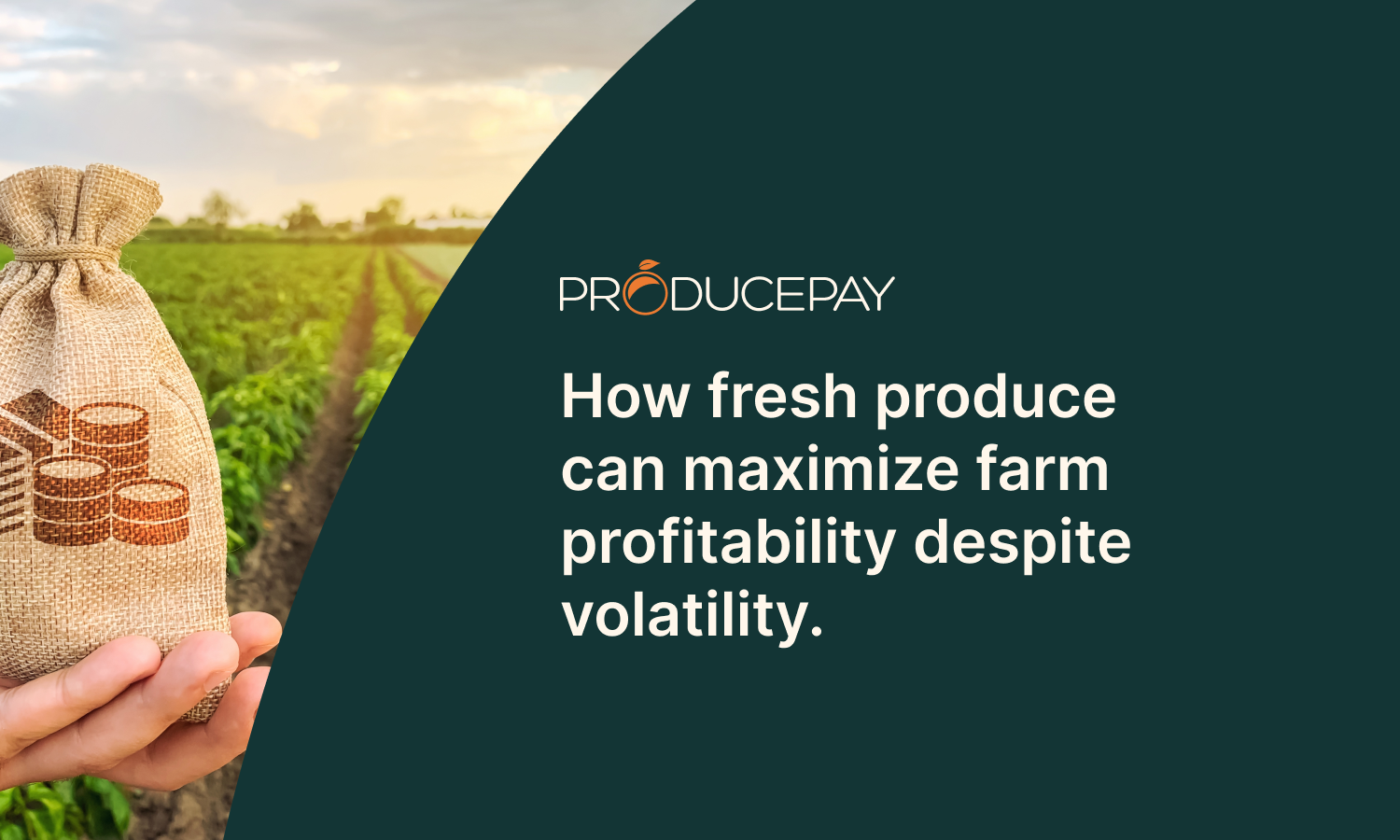
How fresh produce can maximize farm profitability despite volatility
Fresh produce holds tremendous profit potential. In just a decade, the industry is projected to surpass $1.2 trillion, fueled by growing consumer demand for healthy, sustainable foods and increased transparency in sourcing. This growth has created significant opportunities to boost farm profitability across the value chain.
Higher market prices for organic produce and more efficient growing methods can significantly boost returns—especially when growers adopt innovative technologies and solutions.
Yet, fresh produce remains one of the most vulnerable commodities to volatility. Agribusinesses must use the right strategies to capture high-margin growth without falling prey to risk.
Why volatility threatens farm profitability
What makes fresh fruits and vegetables particularly vulnerable is their perishability and sensitivity to timing. A delayed shipment, sudden weather swing, price dip, or global economic change can wipe out margins very quickly.
These risks are compounded as global food markets become more financialized, which has transformed agricultural commodities into assets. Instruments like derivatives, ETFs, and index funds can trigger price swings that often disconnect from physical realities.
At the same time, limited access to agricultural financing—particularly in emerging markets—prevents many producers from adopting the practices and technologies needed to reduce risk. More than 90% of Mexican farmers and 75% of U.S. growers are underbanked, limiting their ability to invest in risk mitigation and expansion.
Other systemic issues — such as long chains of intermediaries, logistical delays, and fluctuating consumer demand — further complicate financial planning across the supply chain and can make even the most profitable farm business models vulnerable.
To manage this volatility and consistently unlock profitability, the produce industry must adopt strategies not only to navigate financial instability, but also lead to a sustained growth.
Learn more about how growers can stabilize their income against volatility
Five strategies to strengthen profitability
Despite the challenges, agribusinesses can adopt several strategies to stabilize their income and improve profitability.
1. Financial hedging to manage risks
Hedging tools can protect revenue from unpredictable weather or market fluctuations. Some notable models are:
- Operational Weather Risk Hedging (OWRH): Risk-sharing between growers and buyers (often via subsidies). Works well in moderate weather but falters under extremes.
- Financial Weather Risk Hedging (FWRH): Uses weather-index insurance and derivatives to offset climate-related losses, effective in markets with advanced financial infrastructure.
- Combined Weather Risk Hedging (CWRH): Integrates operational and financial approaches, offering the strongest protection but requiring robust data and institutional support.
When implemented well, hedging improves income predictability and supports long-term planning. It does, however, require financial education, strong partnerships, and oversight to prevent market misuse.
2. Contract farming to build certainty
Contracts give both growers and buyers more control over pricing and supply. Fixed-price or volume agreements—often supported by data and analytics—help stabilize income and reduce the risk of overproduction or shortages.
By setting terms such as quantity, quality, price, and delivery before the season begins, contract farming improves transparency and strengthens trust. These agreements become even more powerful when combined with access to financing, inputs like seeds and fertilizers, and technical support.
Contracts offer a proactive way to reduce uncertainty and improve efficiency across the supply chain—especially when supported by complementary risk-management tools.
3. Ag-specific financing to unlock growth
Access to adequate and timely financing remains one of the greatest barriers to profitability in agriculture. Long cycles, climate sensitivity, and high upfront costs increase perceived risk for lenders.
This is why traditional financing institutions typically require collateral, extensive paperwork and very strict requirements that many growers can’t meet.
Without tailored options, growers are forced to cut back on essential inputs, delay investments, or avoid growth opportunities — all of which directly impact yield, quality, and margins.
However, agricultural financing models are emerging. These solutions aim to match financial support with actual needs — such as inputs, better irrigation systems, infrastructure, or post-harvest investments — ensuring production and market demands can be met on time.

4. Forecasting tools to enlighten the supply chain
Forecasting technologies are revolutionizing decision-making across the produce industry. These tools combine predictive analytics, machine learning, remote sensing, and IoT to generate real-time insights based on vast datasets.
They analyze historical and live data—from satellites, crop sensors, weather feeds, and market trends—to predict yield risks, price movements, and optimal harvest times.
For growers, this means improved planning, better input management, and fewer losses. For buyers, it means more accurate procurement, steadier quality, and reduced exposure to supply gaps.
AI-enhanced models can now offer price predictions with greater accuracy than traditional methods, strengthening negotiations and risk mitigation across the board.
Wider adoption depends on cost, usability, and trust. But with tailored training, transparent algorithms, and public-private support, these tools are set to become indispensable assets across the value chain.
5. Product differentiation to add value
In an increasingly competitive and commoditized produce market, differentiation is a key strategy to protect margins. For growers, enhancing product quality and adopting sustainable practices can open doors to premium markets and loyal buyers.
In turn, for buyers, differentiated produce helps meet evolving consumer expectations, strengthens brand reputation, and ensures more consistent supply from trusted partners.
Investing in improved varieties, precision farming, and better postharvest handling allows to deliver higher-quality produce that meets strict specs and fetches better prices.
Differentiation through traceability, powered by digital tools and transparent supply chains, further increases confidence across the supply chain and consumer trust.
Platforms providing predictability are key for fresh produce
While volatility will always be part of agriculture, a growing set of platforms are making it easier to manage uncertainty — and turn unpredictability into a strategic advantage.
These platforms integrate multiple solutions, from financing and forecasting to traceability and supply chain visibility, helping growers and buyers make more confident, data-driven decisions.
With access to better information, more flexible capital, and real-time insights, market participants can secure more stable prices, reduce losses from delays or rejections, and ultimately build longer-lasting commercial relationships. For buyers, it means more dependable sourcing and fewer surprises. For growers, it translates into stronger cash flow, higher quality, and better planning.
ProducePay offers an integrated solution with their Predictable Commerce Programs, allowing growers and buyers to set volume and price terms ahead of the season — while also enabling access to financing, reducing exposure to price volatility and liquidity gaps. Meanwhile, Visibility delivers real-time updates during harvest and shipment, improving coordination and reducing costly disruptions.
By making supply chains more transparent, collaborative, and responsive, platforms like this are not just helping fresh produce survive volatility — they’re helping it thrive.
Sources:
- Weather risk hedging mechanism for contract farming supply chain with weather-dependent yield
- Food Financialization: Impact of Derivatives and Index Funds on Agri-Food Market Volatility.
- Financial Speculation Impact on Agricultural and Other Commodity Return Volatility: Implications for Sustainable Development and Food Security
- Financial stress and realized volatility: The case of agricultural commodities
- Meegle. Predictive Analytics For Agricultural Forecasting Tools.
- Farmonaut. Price Forecasting of Agricultural Commodities.

